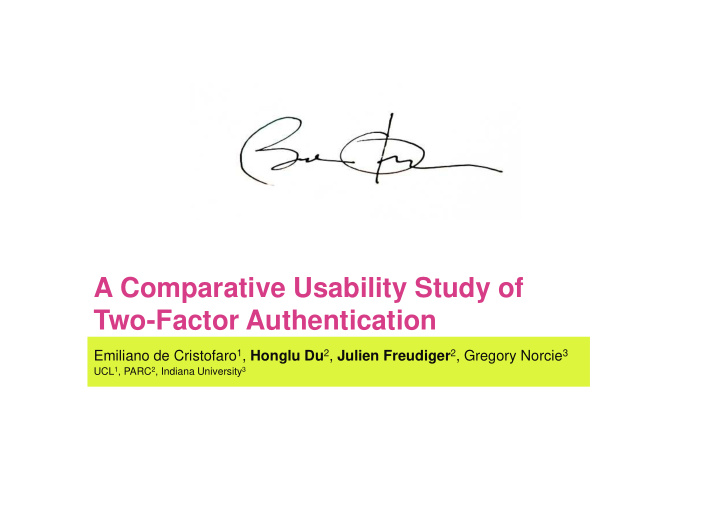



A Comparative Usability Study of Two-Factor Authentication Emiliano de Cristofaro 1 , Honglu Du 2 , Julien Freudiger 2 , Gregory Norcie 3 UCL 1 , PARC 2 , Indiana University 3
Website/Service Token password Fingerprint Phone PIN Retina Smart Card Pattern Palm Possession Knowledge Inherence 2 A. Adams and M. A. Sasse. Users are not the enemy . 1999
+ - Less usable More secure Slower Unfamiliar N. Gunson et al. User perceptions of security and usability of 1F and 2F in automated telephone banking , 2011 D. D. Strouble et al. Productivity and usability effects of using a two-factor security system , 2009 3 C. S. Weir et al. Usable security: User preferences for authentication methods in ebanking and the effects of experience , 2010
Observations Large offering of two factor solutions Lack of metrics to measure 2F usability Problem Problem Is there a difference in usability among 2F? Contributions Comparative usability study Pre-study interview Explorative quantitative study 4
Goal Understand popular 2F in use, context and motivations Participant Recruitment Mailing lists and social media (Google+ and Facebook) Mailing lists and social media (Google+ and Facebook) Announced paid interviews for user study on authentication Online screening survey to know more about potential participants 9 out of 29 mostly from Silicon Valley, familiar with 2F 5
Context Adoption Motivation Forced to Work Incentivized Personal Security token Wanted to Financial “I use 2F to obtain higher limits on SMS or email Smartphone app online banking transactions” “I use 2F to avoid getting hacked” 6
QUANTITATIVE SURVEY “An artisan must first sharpen his tools if he is to do his work well.” Confucius 7
Two main challenges How to recruit participants? What questions to ask? Existing usability metrics SUS - System Usability Scale (10 questions) QUIS - Questionnaire for User Interface Satisfaction (27 questions) PUEU - Perceived Usefulness and Ease of Use (12 questions) CSUQ - Computer System Usability Questionnaire (19 questions) … Software focused, not for 2F technologies 8
Concentration Quick Helpful User Friendly Not Enjoy Stressful Convenient Convenient Enjoy Enjoy Reuse Need Instruction Secure Trust Frustrating Match Easy J. Bonneau, etc. The quest to replace passwords: a Framework for comparative evaluation of web authentication schemes. IEEE Symposium on Security and Privacy, 2012. 9 A. Karole, etc. A comparative usability evaluation of traditional password managers. In ICISC, 2011.
Online survey 219 participants from Mechanical Turk SUS and 15 other questions on usability Group Group 2F Technologies Used 2F Technologies Used # of Participants # of Participants 1 Token 11 2 Email/SMS 77 3 App 7 4 Token & Email/SMS 29 5 Token & App 3 6 Email/SMS & App 50 7 All three 41 Total 219 10
Adoption SMS/Email is the most popular 2F (89.95%) App (45.20%) Token (24.20%) Context Token Token Email/SMS Email/SMS App App Work 39.18% 15.46% 45.36% Personal 15.77% 54.48% 29.75% Financial 69.42% 20.39% 10.19% Χ 2 (4, 582)= 65.18, p<.0001) 11
Motivations Forced Incentive Voluntary App 9.25% 53.18% 37.57% Email/SMS 11.65% 44.48% 43.52% Token 19.73% 35.37% 44.90% Χ 2 (4, 775)= 14.68, p<.0001) 12
Concentration Quick Helpful User Friendly Not Enjoy Stressful Convenient Convenient Enjoy Enjoy Reuse Need Instruction Secure Trust Frustrating Match Easy J. Bonneau, etc. The quest to replace passwords: a Framework for comparative evaluation of web authentication schemes. IEEE Symposium on Security and Privacy, 2012. 13 A. Karole, etc. A comparative usability evaluation of traditional password managers. In ICISC, 2011.
Ease of Use Cognitive Efforts Trustworthiness Quick Need Instruction Trust Convenient Concentration Helpful Enjoy Enjoy Stressful Stressful Secure Reuse Match Not Enjoy Frustrating User Friendly 32% 15% 14% Variance Explained 14
Token Email/SMS App 7 6 5 4 4 3 2 1 0 SUS Ease of Use Cog. Efforts Trustworthiness 15
MANOVA analysis (groups 4, 6 & 7) DVs: Ease of use, Cognitive Efforts and Trustworthiness IV: Technology (2F technologies used) Covariates: Age and gender Results Results No main effect of Technology Some usability differences w.r.t age and gender: Email/SMS and Token users (group 4) The elderly (Md=3) need more Cognitive Efforts than the young (Md=2, p=0.003 ) Email/SMS and App users (group 6) The elderly (Md=5.5) find that 2F are less trustworthy than the young (Md=6, p=.0007 ) Users of all 3 technologies (group 7) Females (Md=2.75) need more Cognitive Efforts than males (Md=2.0, p=.001 ) 16
Main results Different 2F technologies are preferred in different contexts Did not find usability difference among three 2F technologies Identified two additional dimensions of 2F usability: Cognitive Identified two additional dimensions of 2F usability: Cognitive Efforts and Trustworthiness Future work Larger variety of 2F technologies and participants Develop a usability scale for 2F technologies 17
BACKUP 18
Interviews 1 on 1 meeting, $10 Amazon Gift Card compensation Questions 1. Which 2F have you used? (Adoption) 1. Which 2F have you used? (Adoption) PIN from a paper/card PIN from a paper/card Digital certificate 2. How does 2F work? (Understanding) RSA token code Verisign token code 3. Why do you use 2F? (Motivation) Paypal token code Google Authenticator 4. Recall last time you used 2F? (Familiarity) PIN received by SMS/email USB token 5. What issues do you have with 2F? (Comments) Smartcard 19
Selected 9/29 from survey Most of them from silicon valley Only participants familiar with 2F Age: 21 to 49 Gender: 5 males, 4 females Education: High school to PhD Security: 5/9 background in computer security 20
Recommend
More recommend